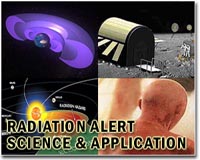 |
Paris (AFP) March 27, 2011 Air-borne nuclear contamination has spread "well beyond" the 30-kilometre exclusion zone around Japan's Fukushima nuclear plant, the head of France's Nuclear Safety Authority (ASN) said Monday. "Beyond 30 kilometres (19 miles), it is clear that there are patches of contamination, and that a certain number of products have been polluted," Andre-Claude Lacoste told journalists at a briefing. "It would not at all be surprising to find, here and there, contamination well beyond a radius of 100 kilometres (62 miles)," he said. While precise measurements of radioactive pollution are still lacking, he added, "it is obvious that managing contaminated areas is going to take years, if not decades." The government last week asked people still living between 20 and 30 kilometres from the plant to leave voluntarily, effectively more than doubling the previous exclusion zone. Even inside the plant, disabled monitors and gauges make it impossible to determine water levels in spent fuel pools, or to know what percentage of fuel rods in the reactors might have melted, Lacoste said. Workers trying to restore systems to cool overheating fuel rods sought on Monday to work around puddles of dangerously radioactive water discovered inside reactor number two. Experts fear that the primary containment vessel housing the number two and three reactors are no longer intact, at that highly-contaminated water could be seeping into the soil or nearby sea. "The situation remains extremely serious, and we remain in a major crisis," Lacoste said. Only with the restoration of the plant's cooling systems and a steady supply of fresh water will it be possible to stabilise the reactors, he added. Daily ASN assessments of the nuclear crisis, caused by the March 11 earthquake and subsequent tsunami, are based on data from French nuclear experts in Japan, Japanese scientists and officials, and other governments monitoring the crisis, he said.
earlier related report The water, found in an underground tunnel linked to the number two reactor at the Fukushima plant, showed a radiation reading of more than 1,000 millisieverts per hour, a Tokyo Electric Power official told reporters. There is estimated to be several thousand cubic metres of water inside the tunnel. "We need to check if the water could flow directly into the sea," he said. Each reactor turbine building is connected to a maintenance tunnel large enough for workers to walk through. In the case of the reactor two tunnel, the water has risen to within one metre (three feet) of the top of a 15.9-metre access shaft which is located 55 metres from the sea, raising concerns it could overflow. Levels of radioactive iodine some 1,850 times the legal limit were reported Sunday several hundred metres offshore, but officials ruled out an immediate threat to marine life and seafood safety. Radiation of more than 1,000 millisieverts per hour was earlier found in water in the turbine building of the number two reactor, delaying urgent work to restore the cooling systems and bring the facility back under control. The exposure limit set by the government for workers at the tsunami-stricken plant is 250 millisieverts per year. A single dose of 1,000 millisieverts can cause temporary radiation sickness, including nausea and vomiting. Workers are trying to pinpoint the exact source of the radioactive water leak, but there are concerns that fuel rod vessels or their valves and pipes are damaged. A March 11 magnitude 9.0 earthquake and towering tsunami knocked out cooling systems for the six reactors at the Fukushima plant, leading to suspected partial meltdowns in three of them. Huge amounts of seawater has been hosed onto the plant in a bid to keep the fuel rods from being exposed to the air, and prevent a full meltdown. The tunnels for reactors one and three are also close to overflowing, but so far workers have not detected such high radiation levels in the water in those, the official said. Nuclear safety agency spokesman Hidehiko Nishiyama said the operator would focus on trying to pump water out of the turbine buildings, which it hopes will ease the problem with the water in the tunnels.
Share This Article With Planet Earth
Related Links Space Technology News - Applications and Research
 Radiation scare at Japan nuclear plant
Radiation scare at Japan nuclear plantKitakami, Japan (AFP) March 27, 2011 Dangerous levels of radiation detected in water thought to be leaking from a stricken Japanese reactor dealt a new setback Sunday to efforts to avert a nuclear disaster. Radiation in puddles near reactor two at the Fukushima plant was more than 1,000 millisieverts per hour, forcing the evacuation of workers toiling to restore the cooling systems, operator Tokyo Electric Power (TEPCO) said. ... read more |
|
| The content herein, unless otherwise known to be public domain, are Copyright 1995-2010 - SpaceDaily. AFP and UPI Wire Stories are copyright Agence France-Presse and United Press International. ESA Portal Reports are copyright European Space Agency. All NASA sourced material is public domain. Additional copyrights may apply in whole or part to other bona fide parties. Advertising does not imply endorsement,agreement or approval of any opinions, statements or information provided by SpaceDaily on any Web page published or hosted by SpaceDaily. Privacy Statement |